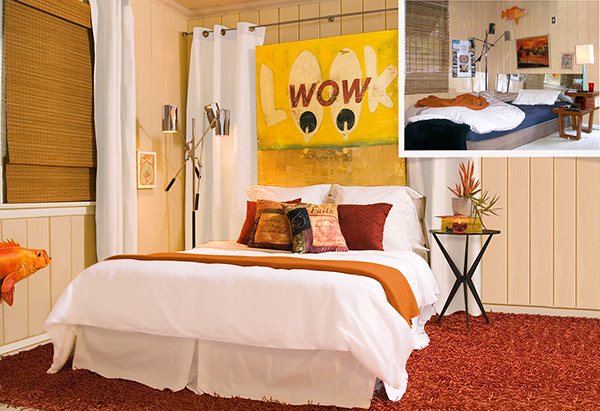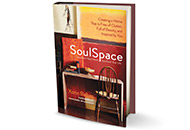Design wizard Xorin Balbes's easy techniques for making where you live the ultimate expression of you.

Photo: Templehome
Imagine this: You head home after a ten-hour workday. Maybe you stop for groceries, then wedge in line behind a woman shouting at 110 decibels on her cell phone. It's raining sideways and traffic is snarled, horns honking, frantic energy in the air. All the stuff of modern life. We deal with it constantly and bear it heroically, but—and this is where the fantasy comes in—imagine that when you open the door to your home, everything changes. The vibe is warm and welcoming, the lighting soft and flattering. The first thing you see when you walk in is a dish of beautiful seashells you collected on vacation; every time you look at them you're reminded of long beach walks and glimmering sunsets. Setting down your bags, you kick off your shoes, so your feet can sink into the plush rug. As you head toward your living room, your favorite song plays subtly in the background.
If experiencing this kind of Zen pleasure in your home sounds preposterous, Xorin Balbes would like to have a word with you. Balbes, a celebrated designer who has done many high-profile architectural restorations and author of the book SoulSpace, believes that making your home a nurturing reflection of your inner self is not only possible for anyone, it's imperative. Whether he's renovating landmark buildings or transforming ordinary residences, his goal is the same: to enhance the true essence of a place, and the people living in it.
In this revved-up, demanding culture, Balbes says, "our homes are our greatest possibility of support. When you are completely in love with where you live, you can go out into the world knowing that you get to come back home and be taken care of."
If you'd like to create your own soul space, follow Balbes's eight steps...
If experiencing this kind of Zen pleasure in your home sounds preposterous, Xorin Balbes would like to have a word with you. Balbes, a celebrated designer who has done many high-profile architectural restorations and author of the book SoulSpace, believes that making your home a nurturing reflection of your inner self is not only possible for anyone, it's imperative. Whether he's renovating landmark buildings or transforming ordinary residences, his goal is the same: to enhance the true essence of a place, and the people living in it.
In this revved-up, demanding culture, Balbes says, "our homes are our greatest possibility of support. When you are completely in love with where you live, you can go out into the world knowing that you get to come back home and be taken care of."
If you'd like to create your own soul space, follow Balbes's eight steps...
1. Assess
First, step back and consider your home like a neutral observer. "The idea is to take an inventory to determine what's in there that you love, and what's just taking up space," Balbes says. Questions to ask include: Which rooms make you feel most comfortable? Is there a room you never use? What's the first thing you see when you wake up in the morning? When you walk through the door? Are there items in your home that no longer reflect who you are? What have you outgrown? Don't make a to-do list yet; just note your strongest impressions, and keep an eye out for hidden inspiration. Says Balbes, "Often our deepest, truest style is represented by a single object in our homes—say, a piece of clothing or jewelry, or a picture."
2. Release
Now it's time to cull. Balbes suggests the following guidelines for separating what to keep from what to sell, donate to charity, give to friends, recycle, or toss:
Let go of anything that...
Is collecting dust
"Garages, basements, and attics are full of items that should be released," Balbes says. "Get rid of all that weight and set yourself free."
Dredges up unpleasant emotions
Even if the item in question is valuable, if its provenance makes you feel crummy, it can't stay. "If you have a chair that's pretty but was an inheritance from a horrid old aunt who was always criticizing you," Balbes says, "let it go. It's an anchor to the past." Likewise, don't keep photos around if you don't adore the people in them.
Doesn't work anymore
If it's damaged beyond repair, outdated enough to be useless, or worn out to the point of shabbiness, give it the heave-ho.
Is uncomfortable
Out with scratchy blankets, chairs that are awkward to sit on, too-tight pants—anything that irritates rather than delights.
Keep anything that...
You love
When evaluating what belongs in your home, Balbes sets the bar high: You must actually love it. And while this kind of emotional connection may seem possible only with things like fine art and keepsakes, he believes that even mundane objects (think spatulas and bath towels) should make you happy when you use them: "Everything you surround yourself with either lifts you up or brings you down."
Next: Cleansing the energy of your home
3. Cleanse
You've decided what will stay and what must go. Now break out the vacuum cleaner, the wood polish, the iron—and care for your home. Open your windows and let in the breeze. Replace lightbulbs. Rotate your mattress. Tend to necessary repairs. At the same time you're literally cleaning your environment, Balbes says, you also want to clear out any emotional cobwebs. In rooms where you've experienced loss or pain, he recommends burning sage or sweetgrass, an energy cleansing technique favored by Native Americans. Balbes refers to this phase as "spring cleaning for the soul."
4. Dream
You've released the past; this next phase is all about the future. Who are you now and who do you want to become? "Let yourself experience new things," says Balbes. "Go to new restaurants, roam around new neighborhoods—it's about getting inspired." You might make a vision board, filling it not with standard-issue photos of mega-mansions but with images that make your spirit soar. Maybe you dream of sailing, or English gardens, or Bali. "You want to go into a very meditative mode of just flipping through magazines and tearing out things you feel a connection with," Balbes says. "Don't do it from a place of thinking."
5. Discover
Now bring those dreams to life by finding the objects that express your true self. Look at catalogs. Browse flea markets. Surf websites like eBay, Craigslist, and Etsy. "I think people get stuck in routines and styles," Balbes says. "It's important to open up. Let your imagination lead the way."
6. Create
Your budget will dictate the scope of your improvements, but even minor changes can make a big difference. You might rearrange the furniture in your living room to make it more inviting for friends to drop by, or move your desk next to a window so it gets more natural light. Want to paint your bedroom sky blue? Hang a chandelier in the bathroom? Now's the time. Expert opinions don't matter here; this process, Balbes stresses, is about "you really making your home yours."
7. Elevate
Now for the finishing touches, or what Balbes calls grace notes. Often we don't make the effort to add a vase of flowers in our favorite colors, turn on some music, and spritz the air with an appealing scent, yet it takes only a moment—and very little cash—to bring in these uplifting elements.
8. Celebrate
"For some people the soul space process might take years to fully express," Balbes says. "But if you can even start it, you're beginning to connect to your true essence." It's important to invite people over to share your home's transformation, he notes, "because when you start living in an environment that's more like you, then others can see more of you. And hopefully you're inspiring them to become more of who they are, too."
 Xorin Balbes is the author of SoulSpace (New World Library).
Xorin Balbes is the author of SoulSpace (New World Library).
Create a Relaxing Space




